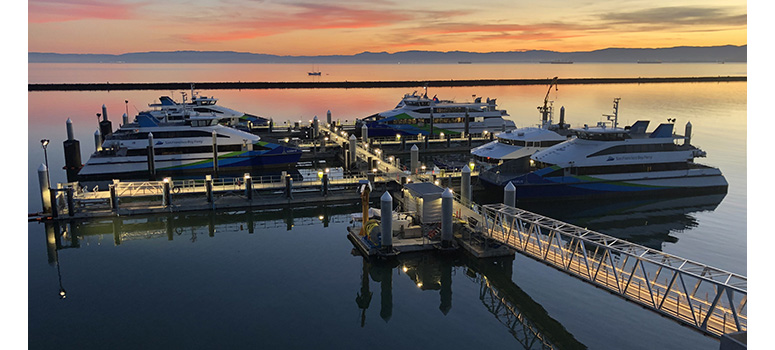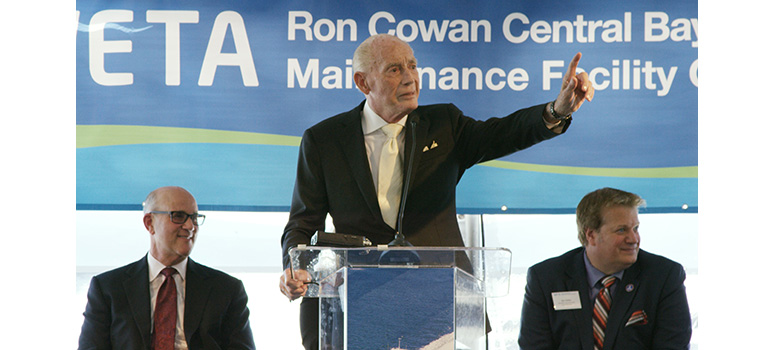The San Francisco Bay Area Water Emergency Transportation Authority (WETA) officially commenced operations last month at the new Ron Cowan Central Bay Maintenance and Operations Facility in Alameda.

Photo courtesy of WETA
BY JOEL WILLIAMS
Published: January, 2019
The San Francisco Bay Area Water Emergency Transportation Authority (WETA) officially commenced operations last month at the new Ron Cowan Central Bay Maintenance and Operations Facility in Alameda. A large crowd attended the ribbon cutting event in the shadow of the USS Hornet Sea, Air & Space Museum at Alameda Point.
The facility is named after Ron Cowan, an Alameda businessman and lifelong champion for expanded ferry service in the Bay Area. Cowan, who died in January 2017, was responsible for developing most of Alameda’s Harbor Bay in the 1960s.
In 1985, he founded Harbor Bay Maritime for the purpose of providing high-speed ferry service between Harbor Bay Isle and San Francisco. He chaired the Blue Ribbon Task Force that called for the creation of WETA in the 1990s and chaired the Water Transit Task Force in the 2000s. In 2016, the WETA Central Bay facility was dedicated to and named after Cowan in a ground breaking ceremony.
Ron Cowan’s vision of comprehen-sive ferry service included 25 to 40 terminals throughout the Bay Area providing service with 15- to 30-minute intervals throughout the day and into the wee hours of the morning. Although we have not yet reached those lofty goals, ferry ridership continues to rise and WETA is considering a future with ferry service so frequent that riders would no longer need to consult a schedule during certain times of the day.
Cowan had a unique perspective of the Bay due to the fact that he commuted from Marin County to his office in Alameda for 22 years by flying his own helicopter. “The concept of the Bay as a transportation spine was reinforced every day during my flight to work,” he said in a Bay Crossings interview from 2000. “I would get up to 5,000 feet and look down on the Bay Area, and it became obvious to me that the Bay was a wonderful transportation spine connecting the entire region—and it was practically empty. Reinforced images are very powerful, and to look down on this image every day made it clear to me that we here in the Bay Area have an opportunity to create a truly world-class regional water transportation system.”
“This vision was reinforced when I would travel to other parts of the world, particularly Hong Kong, Sydney and Vancouver, demonstrating how other metropolitan areas had taken advantage of their waterways to develop regional transportation systems,” he said. “I often thought that when I had the time, I would like to lead the charge to create such a system.”
During the event to celebrate the opening of the facility, Alameda Mayor Trish Herrera Spencer spoke of Cowan’ vision. “He was a pioneer in understanding the need for a world-class comprehensive regional water transit system to serve our transit needs as well as after natural disasters. It is his vision that ultimately led to the creation of WETA.”
The $50 million facility serves as an operations and maintenance hub for WETA’s San Francisco Bay Ferry fleet serving Alameda, Oakland, Harbor Bay, San Francisco and South San Francisco. It will make routine maintenance and repairs of the vessels more efficient and provide important emergency response capabilities, as providing emergency water transit is a key piece of WETA’s statutory mission. WETA opened its Charlene Haught Johnson North Bay Maintenance and Operations Facility on Mare Island in 2016, which provides similar capability for vessels used in the Vallejo ferry service.
“Our new Central Bay facility is the foundation for the San Francisco Bay Area ferry system of the future,” said Nina Rannells, WETA’s executive director. “WETA’s long-range strategic plan calls for more frequent service and additional terminals: a tripling of the fleet and a quadrupling of ridership. The Central Bay facility will allow that to be possible by making our fleet operations more efficient.”
“We’re honored to have Ron Cowan’s name gracing the building,” Rannells said. “His name is synonymous with ferries in Alameda and beyond.”
The project represents the first new major construction at the former Naval Air Station Alameda and is a part of the Alameda Point development. Features of the new facility include berthing slips for 12 ferry vessels, a dispatch and operations hub with an emergency operations center along with a fueling facility and storage capacity of 48,000 gallons that could potentially sustain ferry operations for a full week during a natural disaster. It also includes equipment and a working yard that support light repair and maintenance work. Other site improvements include the expansion of the San Francisco Bay Trail and a new harbor seal float to prevent habitat displacement.
The cost of the project was funded by State Proposition 1B through the California Office of Emergency Services (Cal OES) and the U.S. Department of Transportation’s Federal Transit Administration. The design-build contractor was a joint venture of Overaa Construction and Power Engineering Construction. WETA’s design team was KPFF Consulting Engineers and ROMA Design Group. The construction manager was 4Leaf, Inc.

In 2016, WETA held a ceremonial ground breaking and dedication ceremony for the new facility. Ron Cowan, who attended the ceremony, died in January 2017. Photo by Joel Williams

Photo courtesy of WETA

